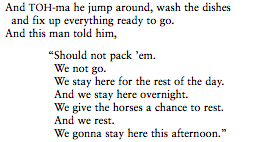Robinson’s interfusion Literature
 In Robinson’s novel, Living by Stories, the story told in, “Coyote Makes a Deal with the King of England”, is said to be a form of interfusion literature. In “Godzilla vs. Post-Colonial“, King refers to Robinson’s stories as interfusion literature, because this identification describes the part of First Nation literature that blends oral and written literature (186). And as King mentions, the way Robinson’s pose is written forces the reader to read aloud, and thus avoiding the loss of the cultural elements of performance and the storyteller from Aboriginal storytelling (186).
In Robinson’s novel, Living by Stories, the story told in, “Coyote Makes a Deal with the King of England”, is said to be a form of interfusion literature. In “Godzilla vs. Post-Colonial“, King refers to Robinson’s stories as interfusion literature, because this identification describes the part of First Nation literature that blends oral and written literature (186). And as King mentions, the way Robinson’s pose is written forces the reader to read aloud, and thus avoiding the loss of the cultural elements of performance and the storyteller from Aboriginal storytelling (186).
Reading to others: When I was the reader and speaker I found the syntax of the story worked very well as an oral piece. The breaks between the lines gave way to natural pauses and the indents used to demonstrate when a character speaks and when there is a narration voice, indicated when I would need to change the tone, pitch or volume. Another thing I noticed when reading out loud is that the syntax reminds me a bit of how plays are written. With the narrator, and speakers being indicated, though it didn’t have stage direction that plays usually do, the format encourages me to make different voices and move positions when I read it to my friends. I used a lot of exaggerated hand motions and even shifted positions, if two characters were having a conversation I’d look to the side.
Listening to the story: When I was the listener to the story it was a bit strange because I knew how the story went but it sounded a bit different. Since it was told by a different person, the tone and voices that my friend used were different from my own and so were the parts were empathized by her use of breaks and volume. For voices such as the narrator and Coyote, we used different types of voices but breaks and emphasis were generally similar to each other. Another big thing was the telling of the story itself. While I was telling the story to her, I had to work at engaging her and act as the storyteller, as I hadn’t gotten everything such as the style of narration down, I had to work to gather attention. But with her taking the position of the storyteller, I lost the pressure and heard the story in a different way.

Robinson 2013, pg. 82
While I was the listener I felt more distance to the story, it was my job to understand and hear the text. But as the storyteller, my role was to engage and provide performance. As the storyteller, I agree with King, Robinson writes his stories as performance pieces, where it’s easy to turn text into a cohesive, understandable, and engaging oral story. As told by Indigenous foundations, oral traditions is both a dialogue and engagement from, the speaker and the listener are engaging with each other and the story through the dialogue. And I compared it to reading a play, the breaks and labeling of characters that are talking are similar, and both pieces are to be acted out. In the same ways that I find plays are more enjoyable when acted instead of reading, I understand how First Nation stories must have their original elements of performance, as if they are left out it results in a loss of enjoyment and engagement from the reader. Just reading the story as presented, without the oral performance, was less engaging and had less of a memorable impact on me as a story.
Reference:
King, Thomas, ‘Godzilla vs. Post‐colonial’,World Literature Written in English, 30.2 (1990), 10–16 <https://doi.org/10.1080/17449859008589128>
‘Oral Traditions’ <https://indigenousfoundations.arts.ubc.ca/oral_traditions/> [accessed 16 February 2020]
Robinson, Harry, Living by Stories: A Journey of Landscape and Memory, ed. by Wendy Wickwire, 1 edition (Talonbooks, 2013)
‘Storytelling for All Ages by Cree Elder Phil Umpherville – Aboriginal Tourism BC’ <https://dev.atbc.drivedigital.net/events/storytelling-ages-cree-elder-phil-umpherville/> [accessed 16 February 2020]
Hi Nargiza!
Thank you for your blog post. I enjoyed reading your interpretation of listening to the story from others reading it or reading it orally to others, and the differences it made. I do agree with you that when you are reading it orally or ‘story telling’, you are definitely more engaged. I can definitely see how you would also find there to be breaks in the stories and harder to follow.
I also think that the way you told the story had a large impact on this. Even though you used exaggerated motions when telling the story, it doesn’t mean everyone else would have. Do you think that this played a large role? Or your tone of voice?
Thank you!
Maya 🙂
Hi Maya!
Thanks for your comment! In regards to your question, I had never considered that. I assumed that most of the work in regards to direction in the performance was due to the style of writing that Robinson employed. But now that you’ve mentioned it, it’s an interesting thing to consider, especially since my friend told the story after me and the similarities I noticed maybe due to my own performance. In consideration to that, I think that you maybe on to something. Maybe someone else might have had a completely different way of telling the story, so I agree that the speaker has to form their own way of engagement.
Thanks for your question!
Hi Nargiza,
I felt very similar to you has I read and performed the story. Even when I was trying to read it silently in my head I found it difficult,, it really lends itself to being spoken and acted out.
One thing that occurred to me as I read your post is that Wickwire must have deliberately chosen to record the story in this play-like way. Robinson told the story, but Wickwire wrote and compiled it. That being the case, she must have felt as you do, that the story is best written down as if it’s a play, because in many ways it *is* a play.
Cooper
Hey Cooper,
I’m glad we noticed similar things. The structure of the story gives it so much more personality and life. Plays generally rely on direction and acting ability, but this story was presented without the direction so it’s interesting to see how the formation/syntax of it plays that role.
Thanks for your comment~
Hi Nargiza,
What a great response to this question! It was really interesting to read your perspective, and I was curious to ask wether you preferred telling the story or being the listener? Do you think that having the ability to tell the story using your own techniques allows you to have a better understanding of the text in general?
Thanks for sharing,
Indra
Hi Indra!
Thanks for your comment, I think I prefer being the storyteller to be honest. Maybe it’s because I enjoy talking haha. I do think that being able to tell a story using your own techniques enables use to have a better understanding of the text. Not having to adhere to the exact dialogue but still managing to present the story in an engaging way takes a great deal of understanding of the moral/message and the progression of the story itself.
Thanks for your comment!
Hi Nargiza,
I enjoyed reading your blog post. And I agree with some of the points that you mentioned. It is incredibly awkward to read something that is meant to be said aloud, as there are gestures, tones and movements that are part of the story. I also felt the same way when I read the story out loud to my friend, I continuous made a large effort to keep him engaged, by emphasizing my gestures and tones, depending on the part of the story.
However, what I found interesting was that you felt distant while your friend was reading it out loud to you, and you were the audience. Do you think this could be because of the way your friend read the story? Or do you think this could be a general feeling. I am asking this because oral storytelling was an essential part of Indigenous culture to make connections with the people, and the land around them. And in order to make people feel connected, the story would have to be engaging.
Do you think that perhaps someone who was more connected to the story, and read it out loud to you, it would be more engaging?
Hi Sashini!
Thanks for you comment. To answer your question, I think I worded my post a bit too generally. When my friend read the story to me I was engaged with it, but I think I found my engagement with the story much more interesting when I was the one telling the story. I did find the way my friend read it to me to be engaging as a listener, but I think in part due to my love of activity and storytelling, I would the act of telling the story much more appealing to me. The types of engagement I experienced from when I was the storyteller to when I was the reader were different in that way.
Hey Nargiza!
Sorry for the late comment, I’m just catching up on the last couple of weeks.
Are there other stories that you have read that you thought would be enhanced by being spoken aloud? I thought that your response to question #1 was very thorough and thoughtful. I appreciated your procedural approach as it made the post easy to follow.
Cheers,
Ari
In all honesty I haven’t come by many stories that I thought needed to be read out loud to enhance the experience. The stories that I do tell out loud are more situational stuff that happens in my life, gossip, and entertainment stories, such as horror stories at sleepovers. Another that relates to reading actual written word out loud would be children’s stories, such as Dr. Sues books and others, that allow for voices and exaggerations to gain attention and interests. Maybe fables and plays as well, which I find good read out loud or not.